The Tesla Cybertruck is unlike most any pickup on the market. That’s obvious just by looking at it, given its shape and its stainless steel construction. However, the differences are more than skin deep, as a teardown by engineering firm Munro & Associates readily reveals.
We’ve had experts talk us through some details of the Cybertruck’s suspension before. However, we’re now getting a deeper assessment, thanks to the team from Munro, who have pulled the truck apart and laid the pieces out on a table.
Kevin Harty, Sr. Design Consultant at Munro & Associates, walks us through the suspension design step by step in the company’s latest teardown video. Front and rear, we get some professional insight into why the Cybertruck is built the way it is.
Up Front
The front upper control arms have been a particularly controversial part of the Cybertruck’s design. Lots of folks have commented on the stamped-steel design, which looks relatively lightweight for a heavy off-road vehicle.
However, Harty notes that it’s quite smart from a manufacturing perspective. Typically, upper control arms are manufactured with two steel parts welded together in a “clamshell” design for strength. This comes with approximately double the tooling costs to produce the two individual parts, and it costs money to weld them together, too. The Cybertruck design uses just a single stamped part, significantly reducing the cost of production. The stamped part still requires the bushing mounts to be welded in, but it’s a lot simpler compared to many contemporary designs, he says.
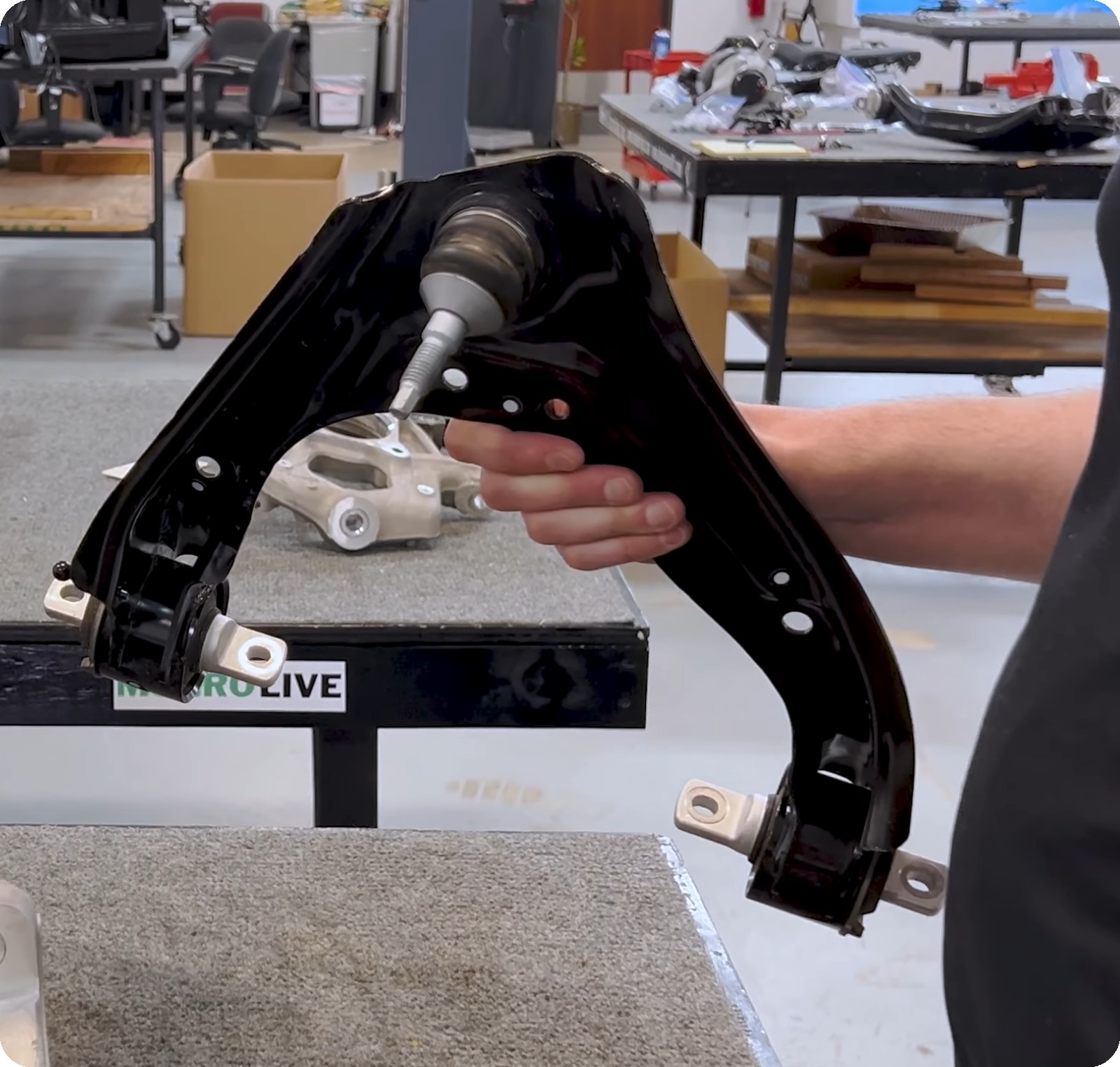
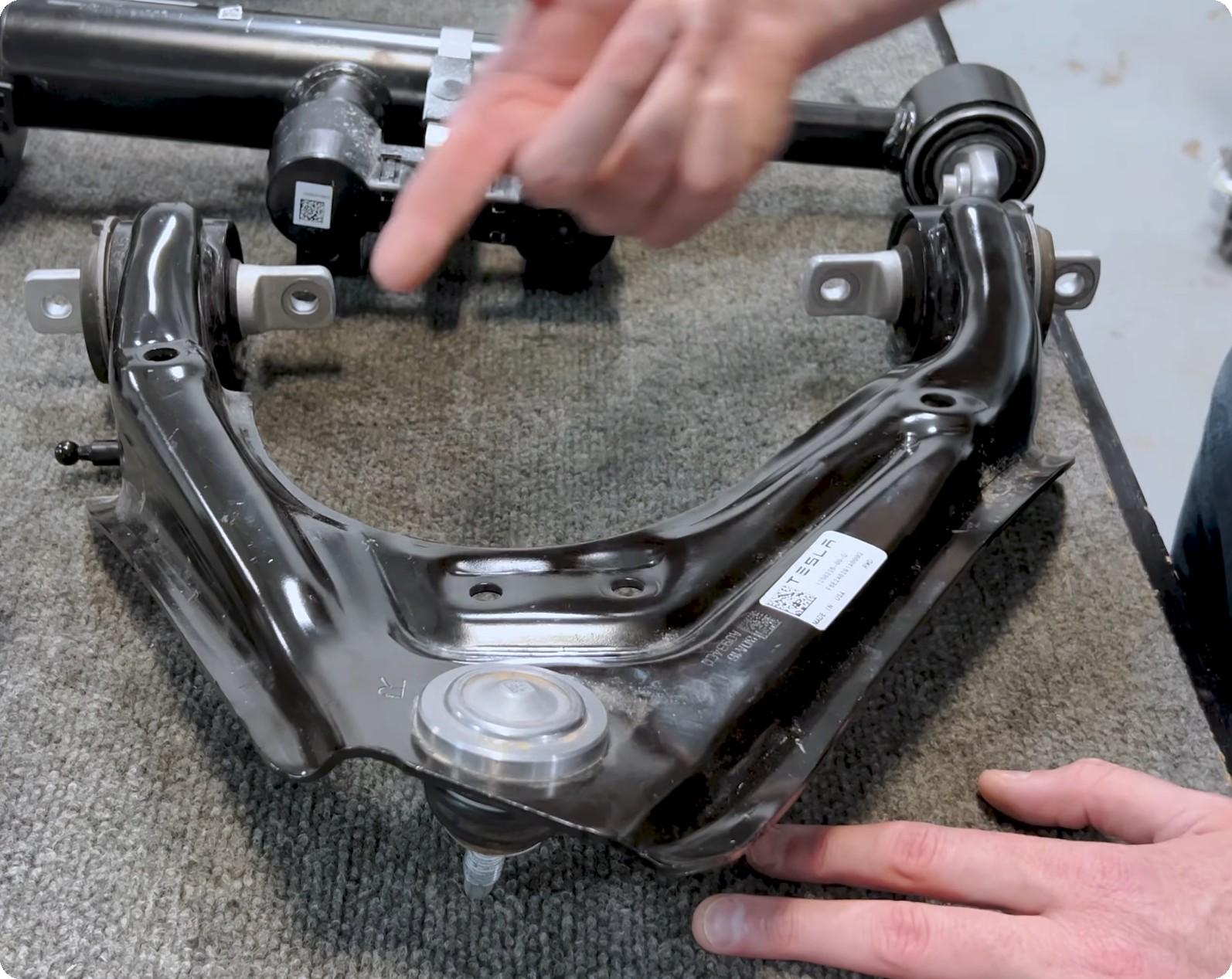
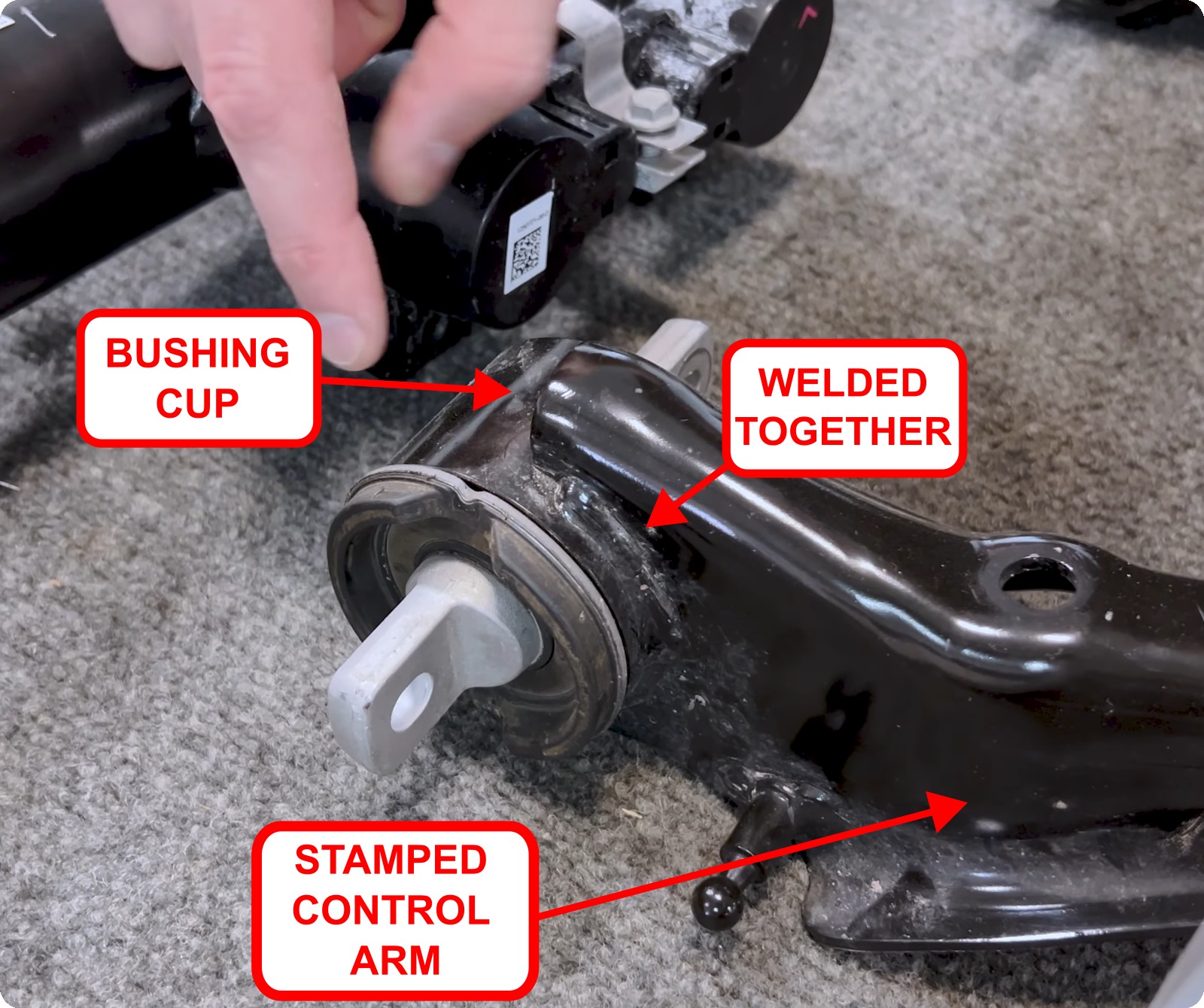
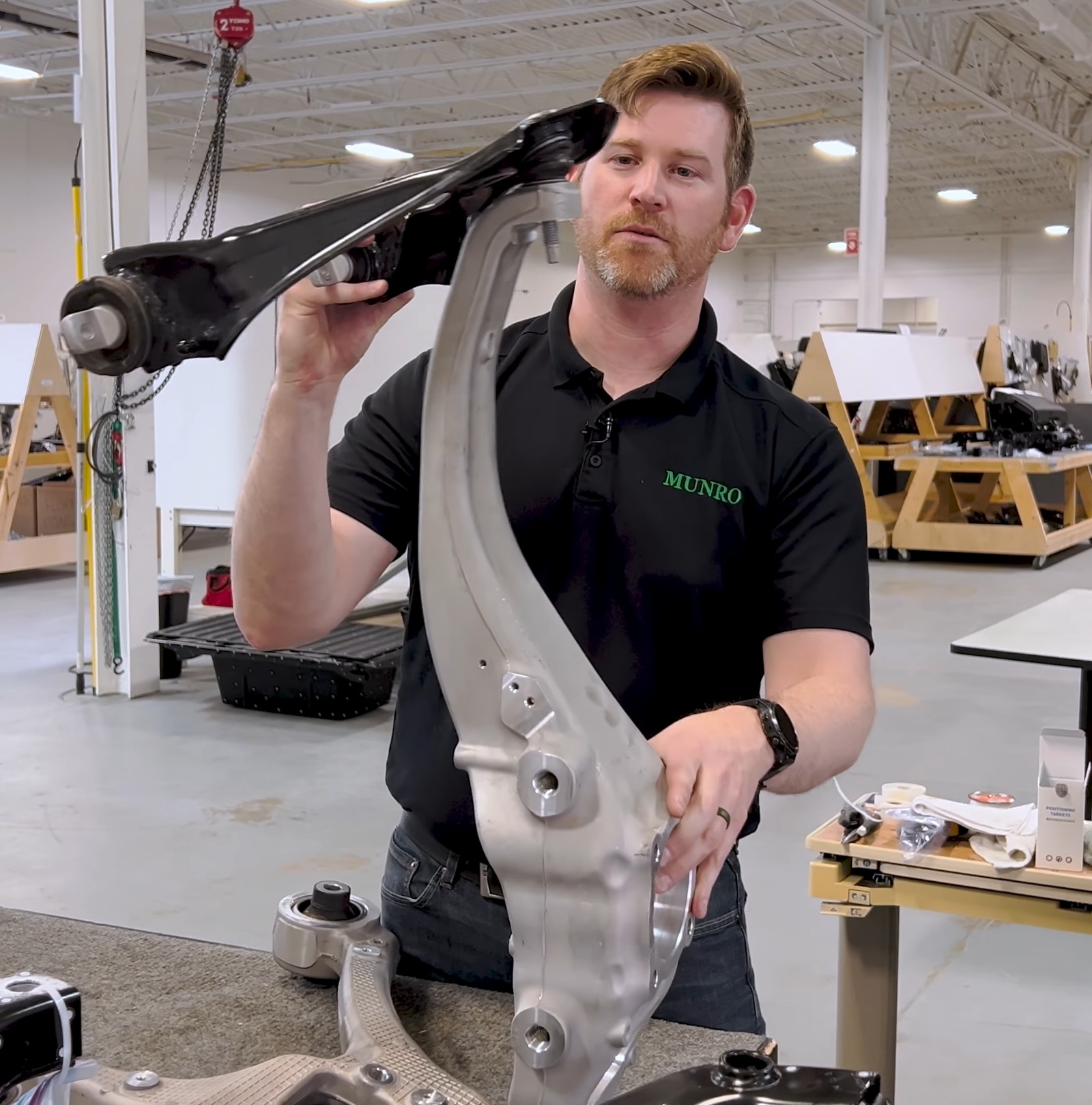
The front knuckle is quite something to behold, given its immense size. “The gooseneck portion of this is arguably one of the tallest that I have seen,” says Harty. It features a deep curve inward to clear the Cybertruck’s large tires, with the upper balljoint mounted directly above the tire tread. Some other brands put the balljoint inboard of the tire, which allows fitment of very large tires. It’s not possible to do this easily on the Cybertruck, as larger tires will foul on the balljoint mounting bolt.
Harty questions whether this packaging choice may be for a reason, given some concerns around the strength of the Cybertruck’s upper control arms. “I wonder, if essentially… is this kind of an enabler to keep the tire size on a Cybertruck relatively reasonable, and therefore the loads brought into the vehicle reasonable and controllable as well.”
.@YammerTime01 @BradMunchen @VickiBryanBondA @Tazerface16 @Karthik48966191
This is a toy suspension–a living joke. Off road in Arizona, New Mexico, Wyoming: mountains, desert, prairie, on any rough, rocky, pothole strewn 4WD road and the casting is cracked and arms are bent. pic.twitter.com/Mf4ArwhhhH
— Very Long Range (VLR) ???????? ???????? ???????? (@ned_christie) November 25, 2023
The Cybertruck’s upper front balljoint design does limit tire size, somewhat. However, our own Huibert Mees doesn’t reckon there’s necessarily a strength issue here. Here’s what Huibert had to say about the upper ball joint being above the tire:
I can assure everyone that this type of suspension design is extremely common and has been on production since the late ’70s when it was first introduced by Mercedes in the W123.
Mercedes uses it. BMW uses it. Ford, GM, VW, Jeep — they all use it. In fact, I can’t think of a single car and truck manufacturer that doesn’t have some form of an SLA in production. Even Tesla uses it on the Model S.
I think what is throwing people off is the fact that the upper arm is so visible in the Cybertruck. Most cars have a much smaller fender-to-tire gap, so the upper arm is only visible if you get up close. With the Cybertruck’s large fender opening, the suspension is very visible, and a shiny aluminum part really stands out.
What this design DOES do, however, is eliminate your ability to install larger tires. A larger tire would interfere with the stud of the ball joint so it just wouldn’t fit. Most trucks that use SLA’s (like the F-150, for example) solve this problem by placing the upper ball joint next to the tire. This keeps it out of the way of a larger diameter tire. It also makes the upper arm and ball joint more difficult to see which is why many people don’t realize these trucks have such a suspension design. You can see that here on my 2020 F150.
David Tracy notes that the Jeep Grand Cherokee also has such a suspension design (see above).
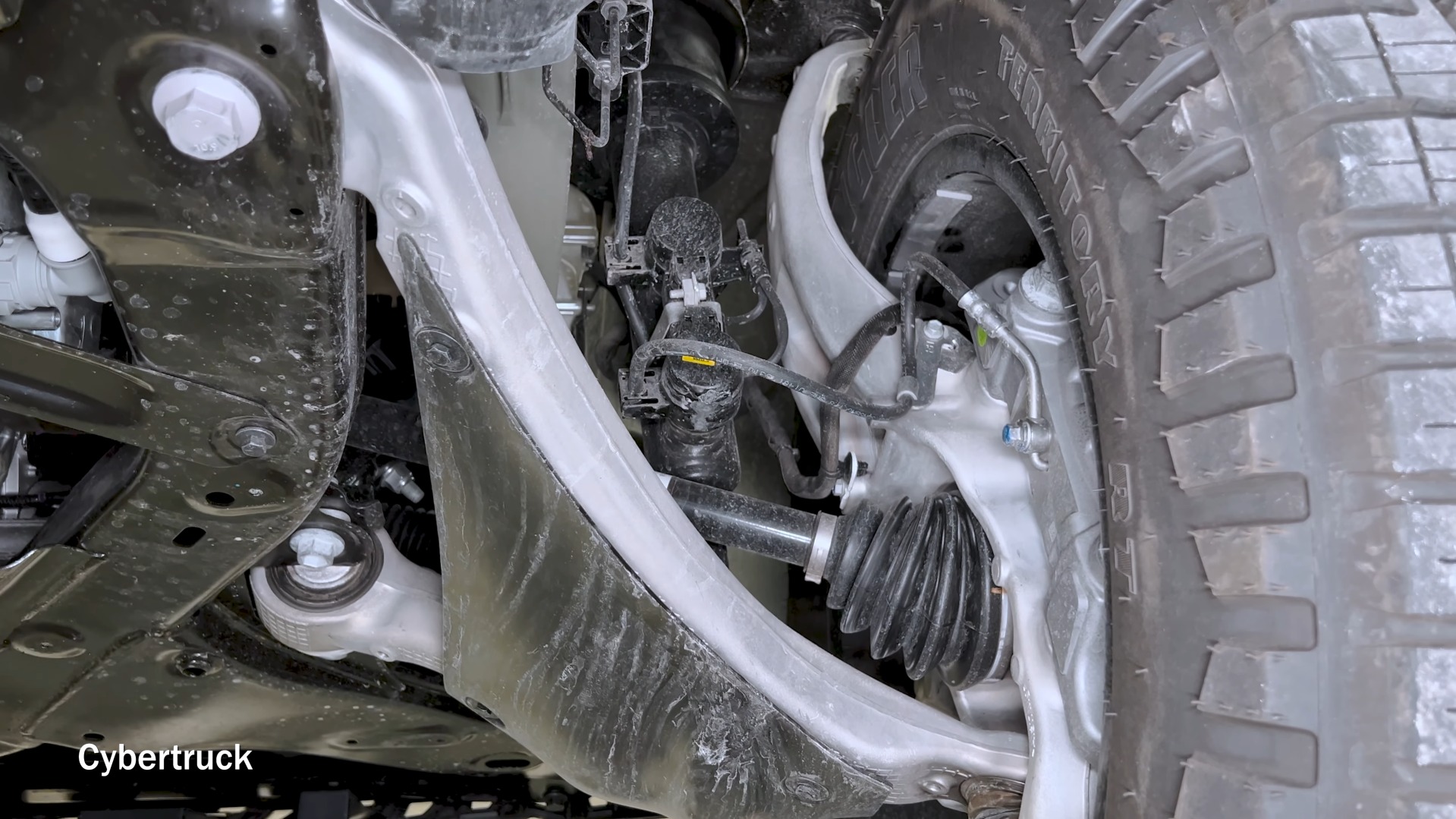

In any case, the design of the Cybertruck’s suspension means that the upper control arm doesn’t see huge loads, anyway. “For this style of suspension setup, not that you don’t see any loads with the upper control arm, but it’s essentially controlling camber,” Harty explains. “[It’s] keeping the wheel from cambering out or cambering in, and it’s controlling the arc of the suspension as it travels through its entire motion.”
Instead, most of the loads are carried by the lower control arm and passed directly into the shock. In comparison to the thin stamped steel of the upper control arm, the lower part is a chunky cast unit. It features a concentric bushing up front, and a perpendicular bushing at the rear. “This is typically for comfort and helping with NVH and locating the wheel itself,” says Harty.
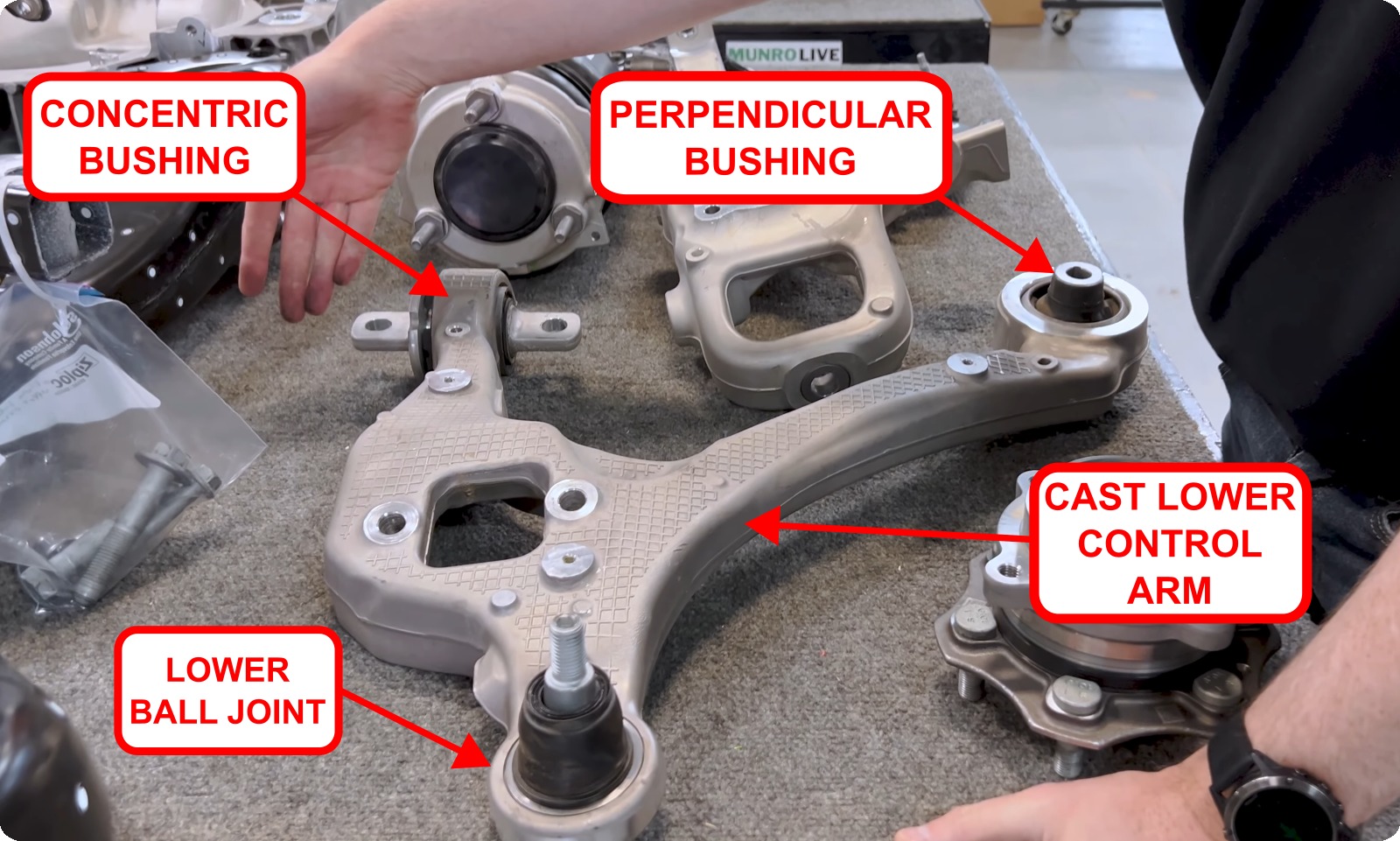
The design of the lower control arm is somewhat more complicated than the upper. That’s down to the need to package it around the wheel envelope, the shock mount, and other components. Harty also notes that aluminum casting is a great choice for making these parts, for strength, weight, and packaging reasons. It allows the creation of complex geometry for tough packaging situations, with minimal wastage. “They’re very efficient as far as how much of the material it takes to make the part ends up being in the part,” he explains. The front lower control arm is the only one made in aluminum, with the rest of the control arms relying on steel, front and rear.

At this time, the jury is still out on the purpose of the little metal nubbin mounted to the upright. When we last looked at this curious part, it appeared to be either a mud scraper or a device used to bust the rim in a crash. Harty also raises the possibility that it could be a tuned mass. However, his leading theory is that it’s used to help the truck pass the Small Overlap Rigid Barrier (SORB) crash test. The nubbin may help destroy the rim or ensure it’s pushed outward during a crash, which helps avoid the wheel and tire assembly impacting or intruding into the cabin. “The proximity for that nugget in relation to the wheel envelope is definitely pushing our opinion… to small overlap and helping with crash [safety],” he says.
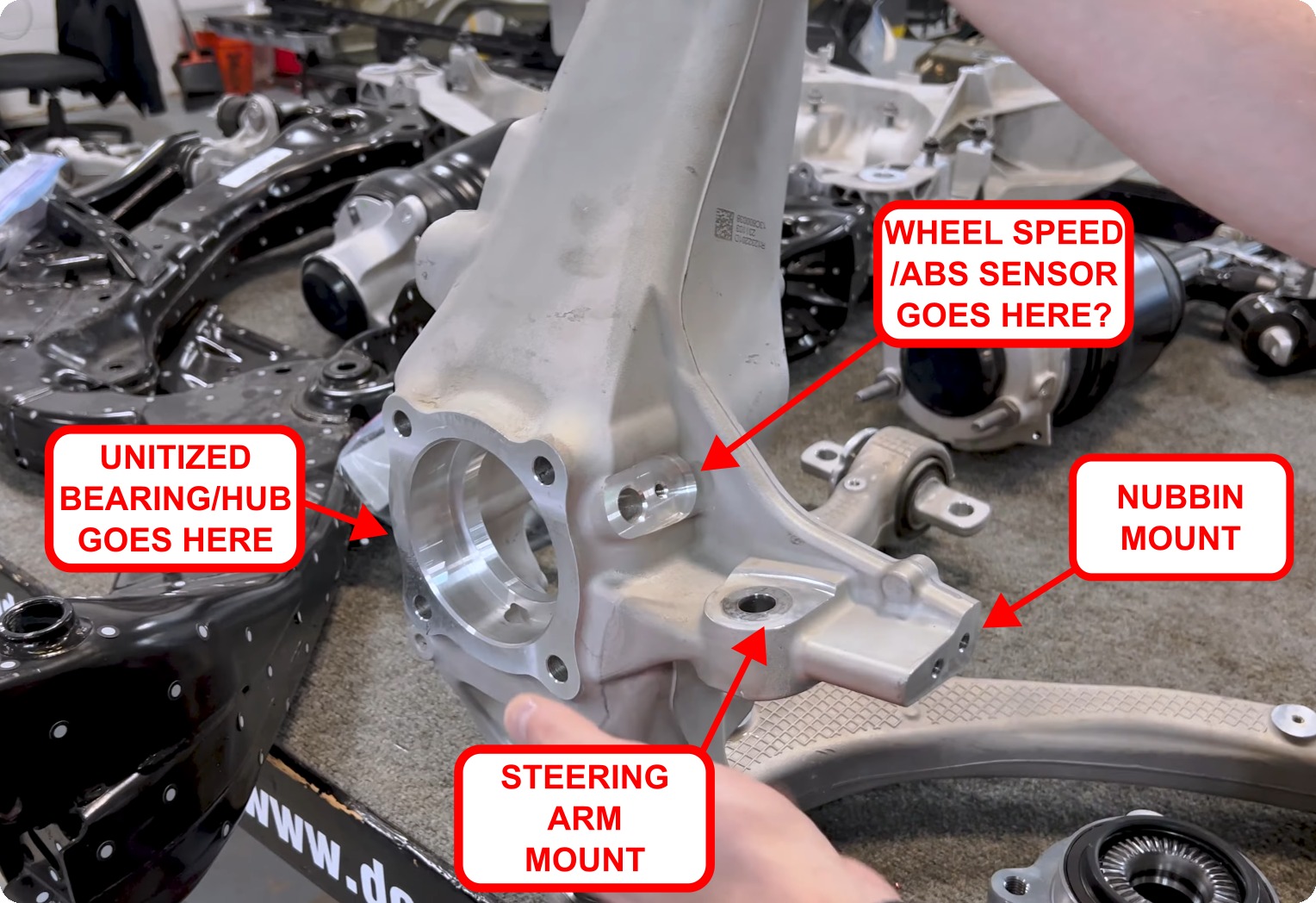
As for the hubs, the Cybertruck has a fairly conventional setup for a modern vehicle. Harty notes the six-lug hubs use “generation 3” style wheel bearings. These are integrated units that combine the hub and bearing into a single replaceable unit, easing maintenance. Otherwise known as “unit wheel bearings,” they also feature the ABS sensor ring as an integral part of the assembly. Harty notes that Hyundai has pushed wheel hub technology further, also integrating the drive axle CV joint into the hub itself on the Ioniq 5. He explains that Munro has been looking for similar parts on vehicles from other automakers, but is yet to find them anywhere else just yet.
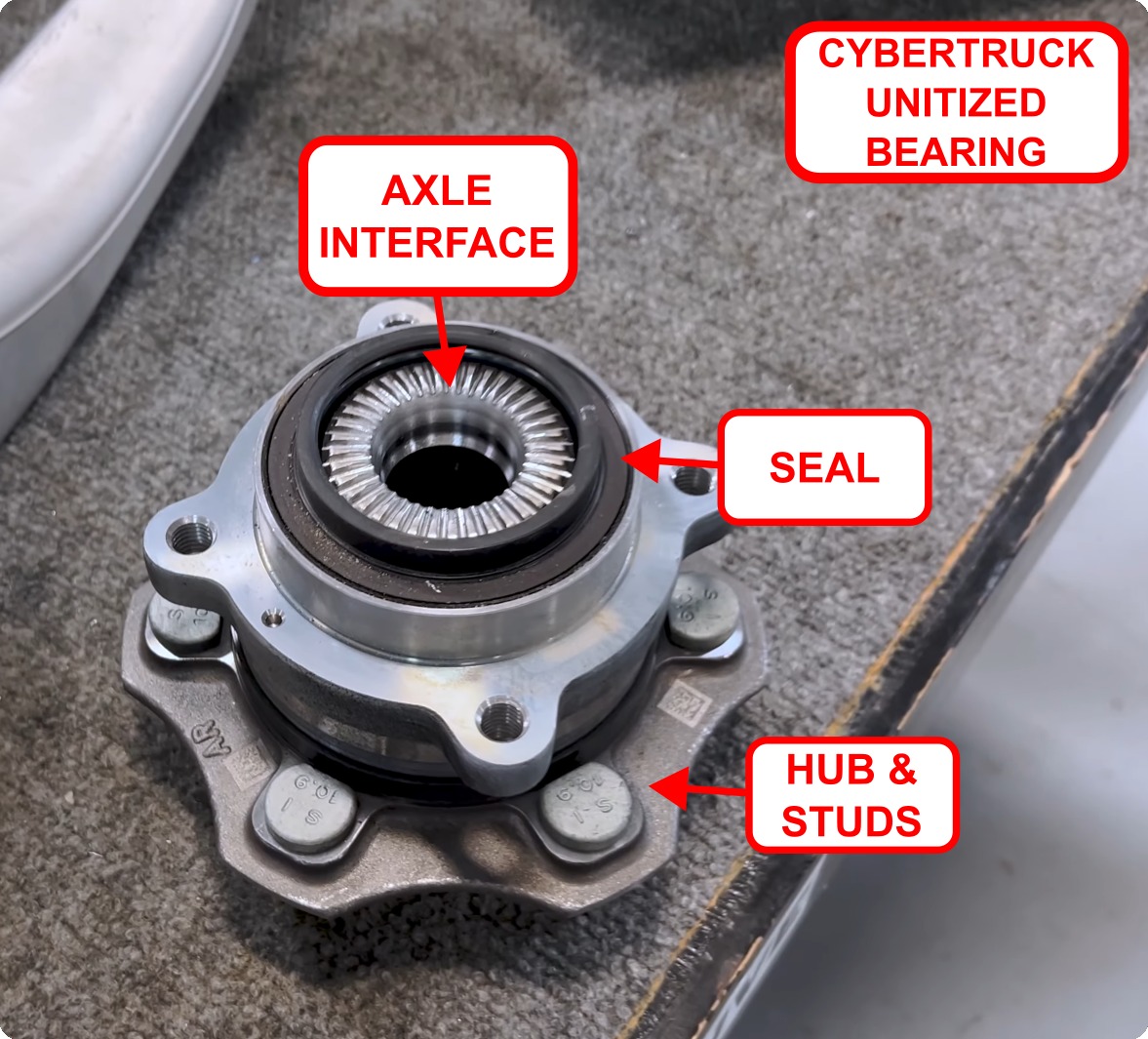
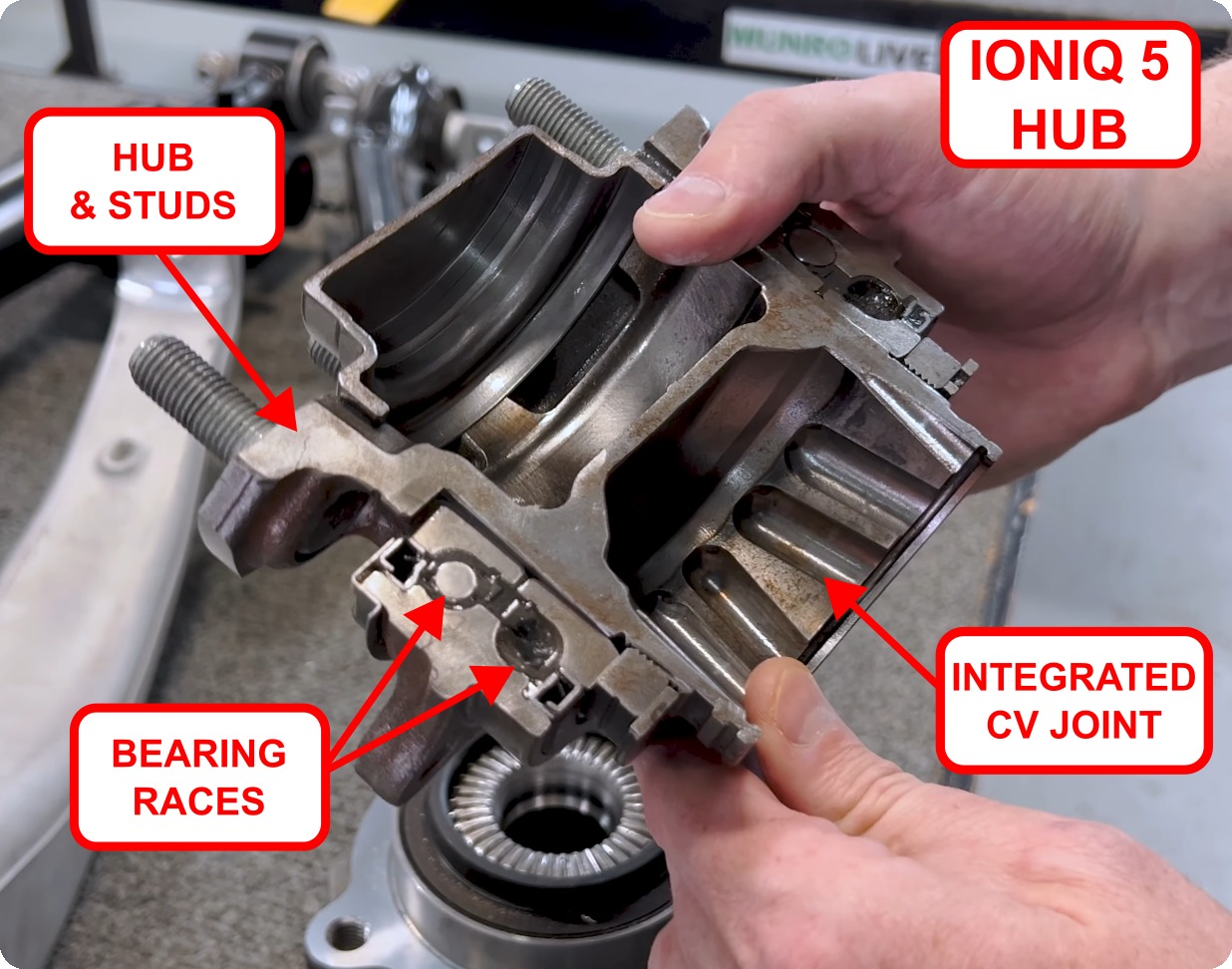
Moving Rearwards
The rear suspension is not entirely dissimilar from the front, at least in its general layout. Rear lower and upper control arms are both made out of stamped steel. The lower uses a clamshell-style design, As for the rear upper control arm, it’s reminiscent to the front part, but it has some reinforcements welded in to add rigidity. Harty also notes the upper control arms are mounted directly to the body. During Cybertruck assembly, the rear drive cradle is then jacked up and installed from underneath, with the upper control arms already in place.
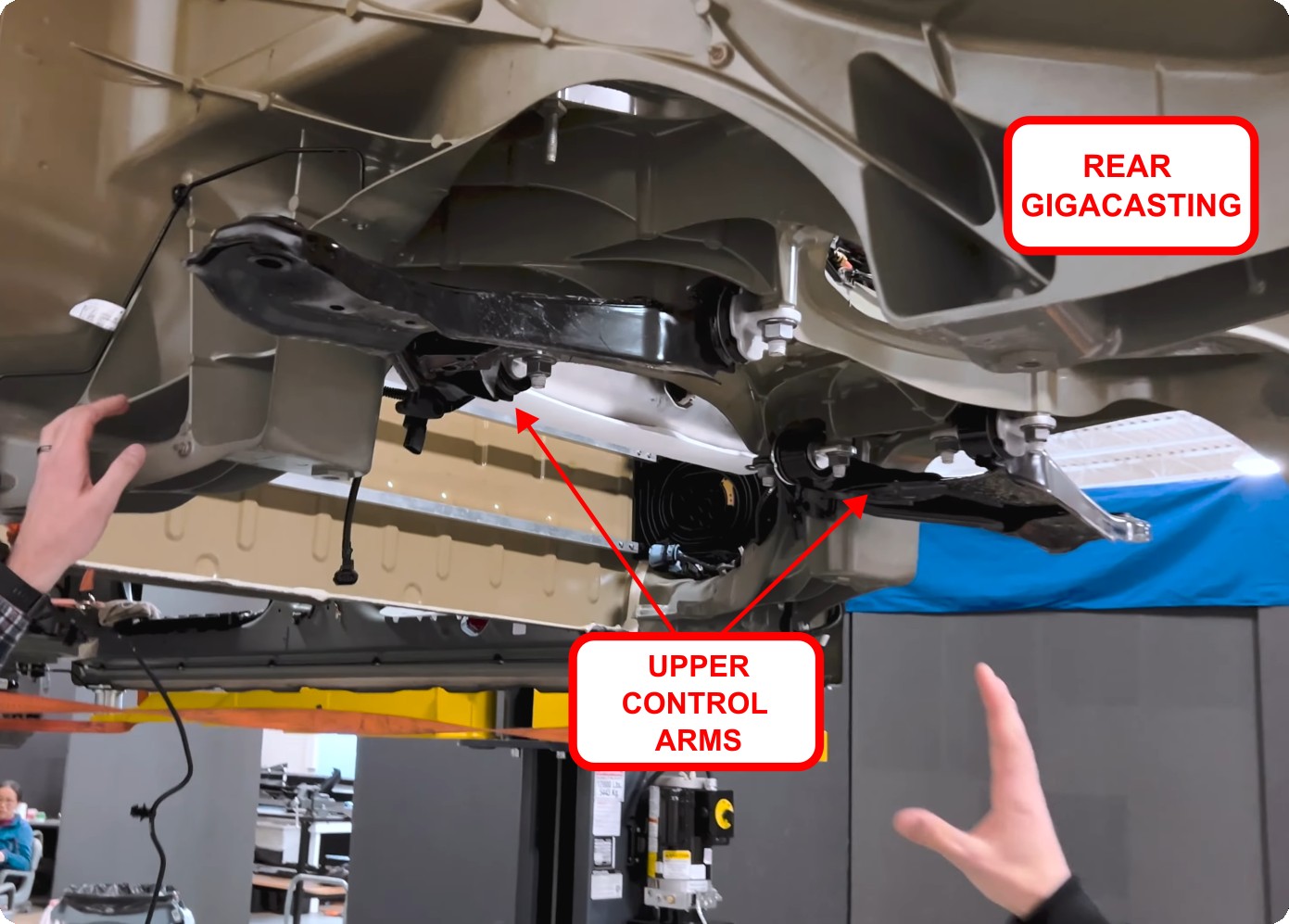
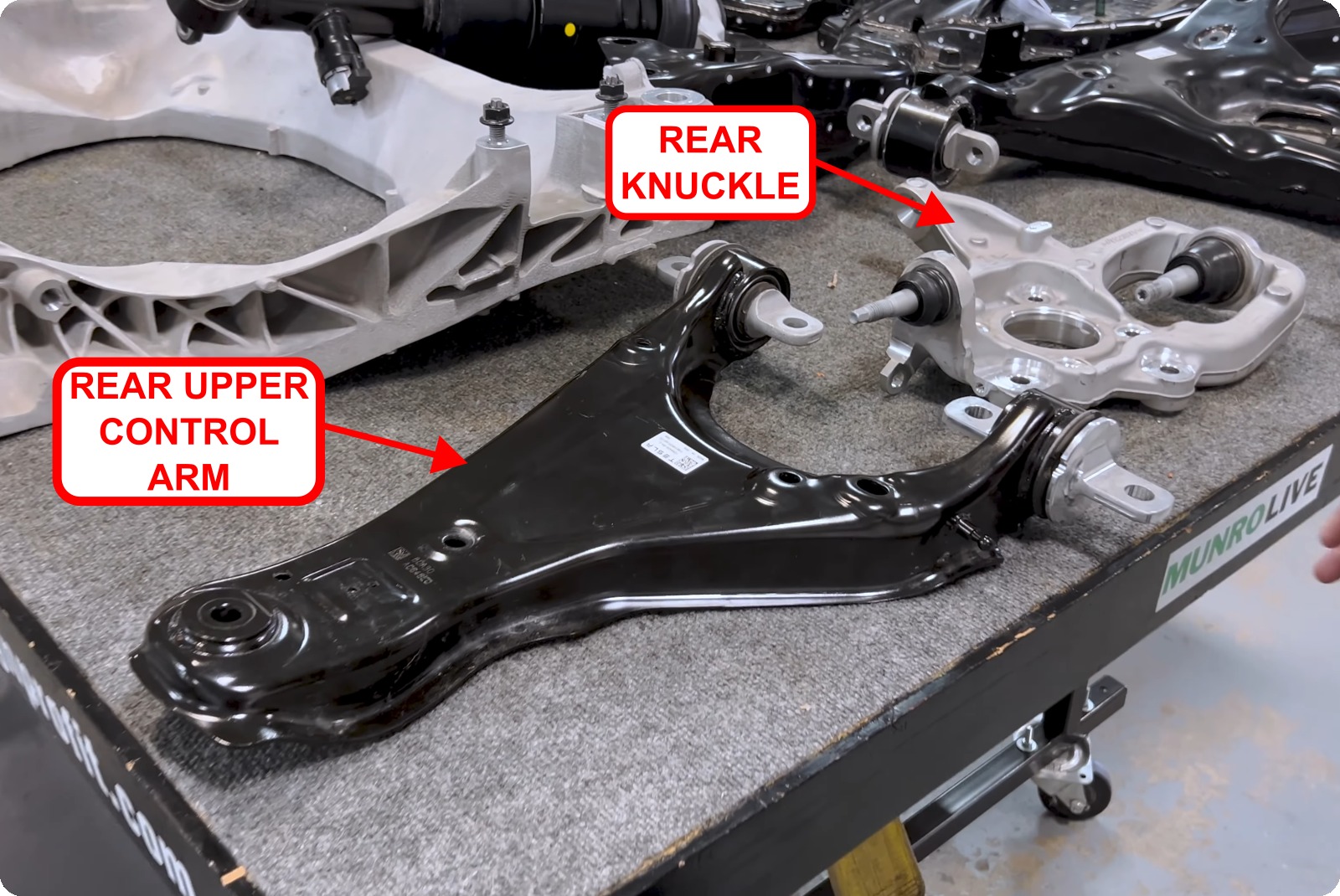
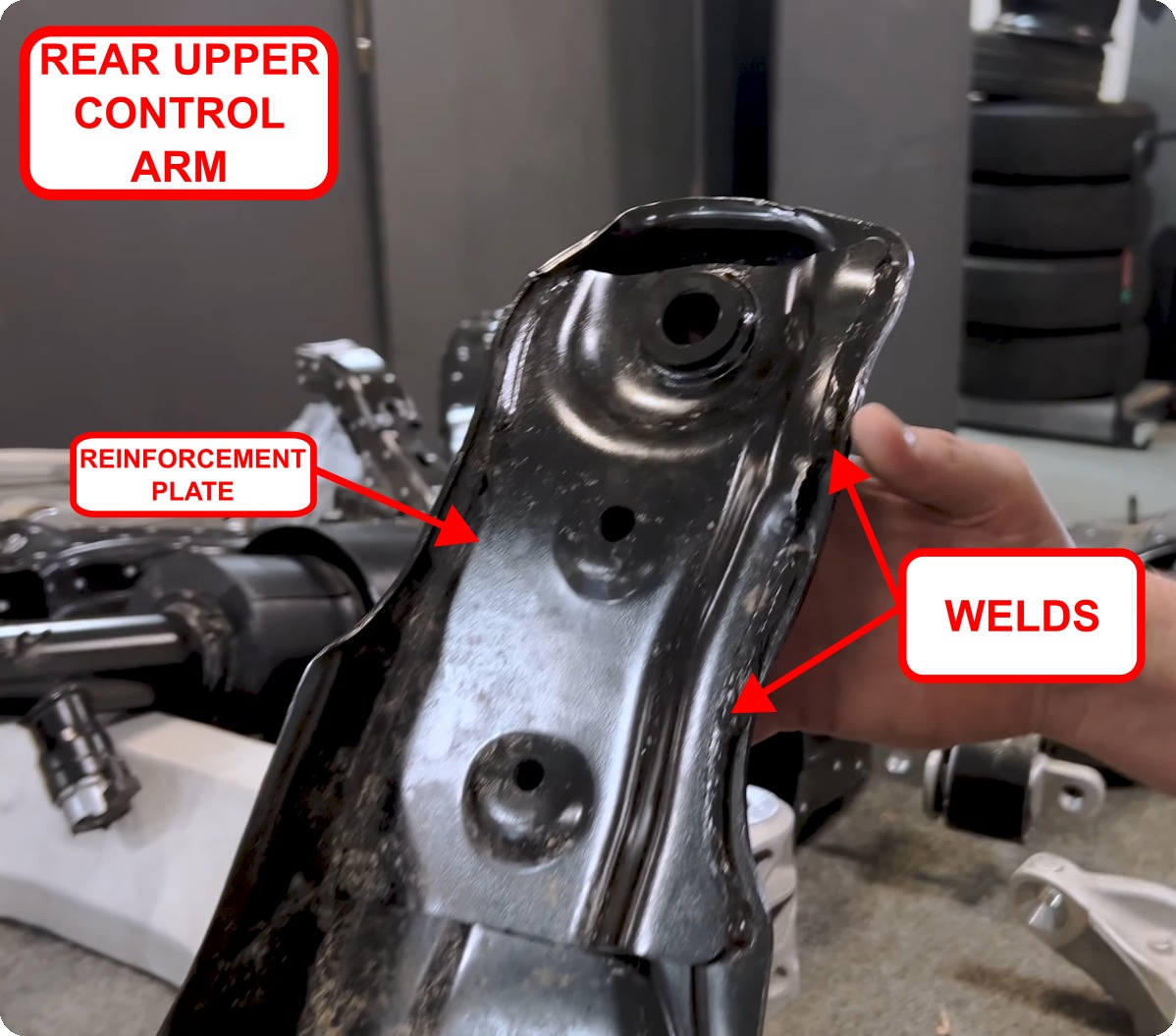
Some of the rear end parts were still in the scanning process at the time of shooting, so we don’t get a good look at them here. Regardless, there’s still plenty to learn. Notably, the rear subframe itself is actually made in China, something Harty notes was also apparent on the Model S Plaid. In contrast, the stamped parts are all marked as being manufactured in the US. “Managing that balance of how many parts are made within the US, [and] how many parts are made outside the United States is important,” says Harty, noting the impact of legislation like the United States–Mexico–Canada Agreement (USMCA).
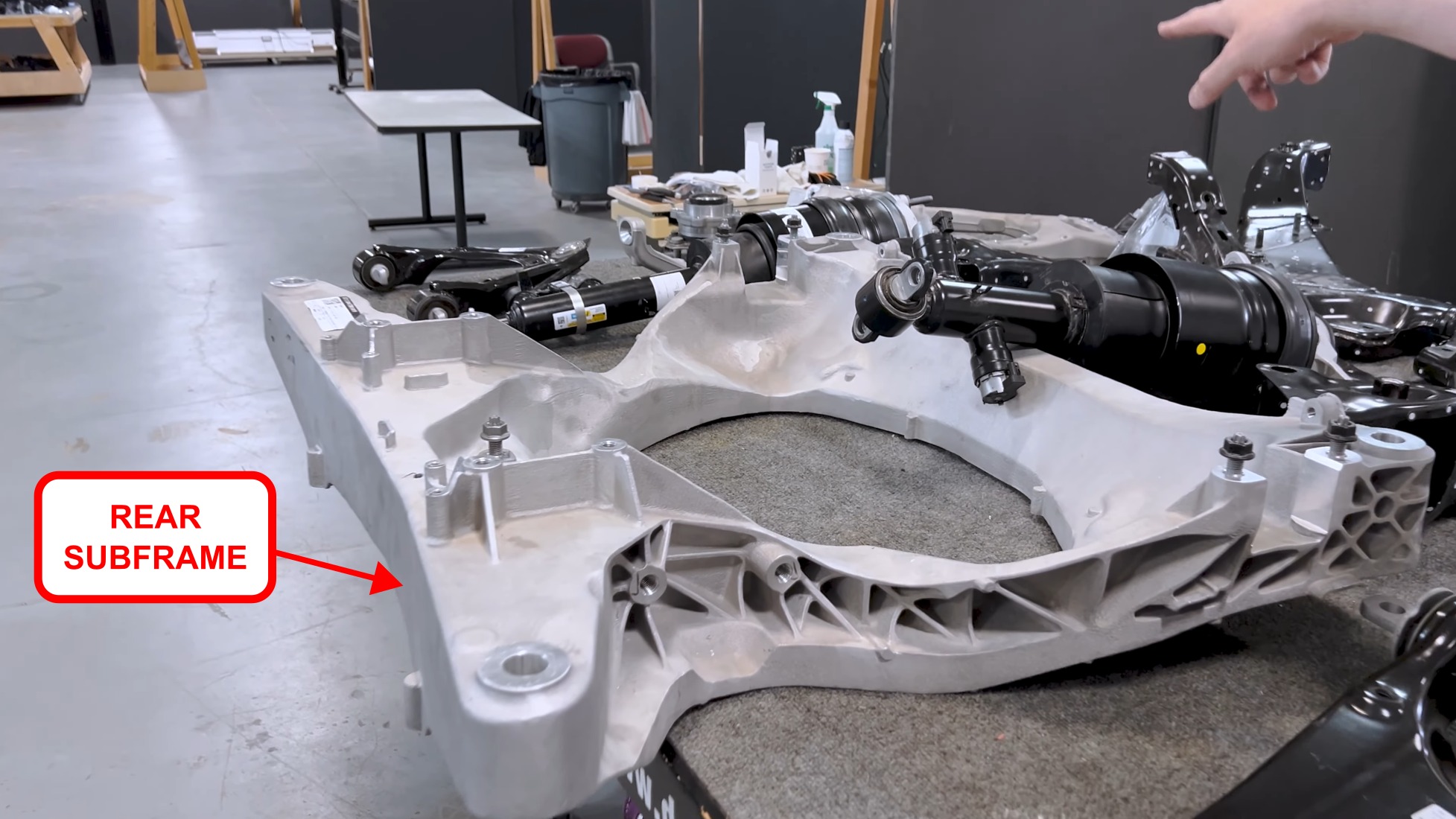
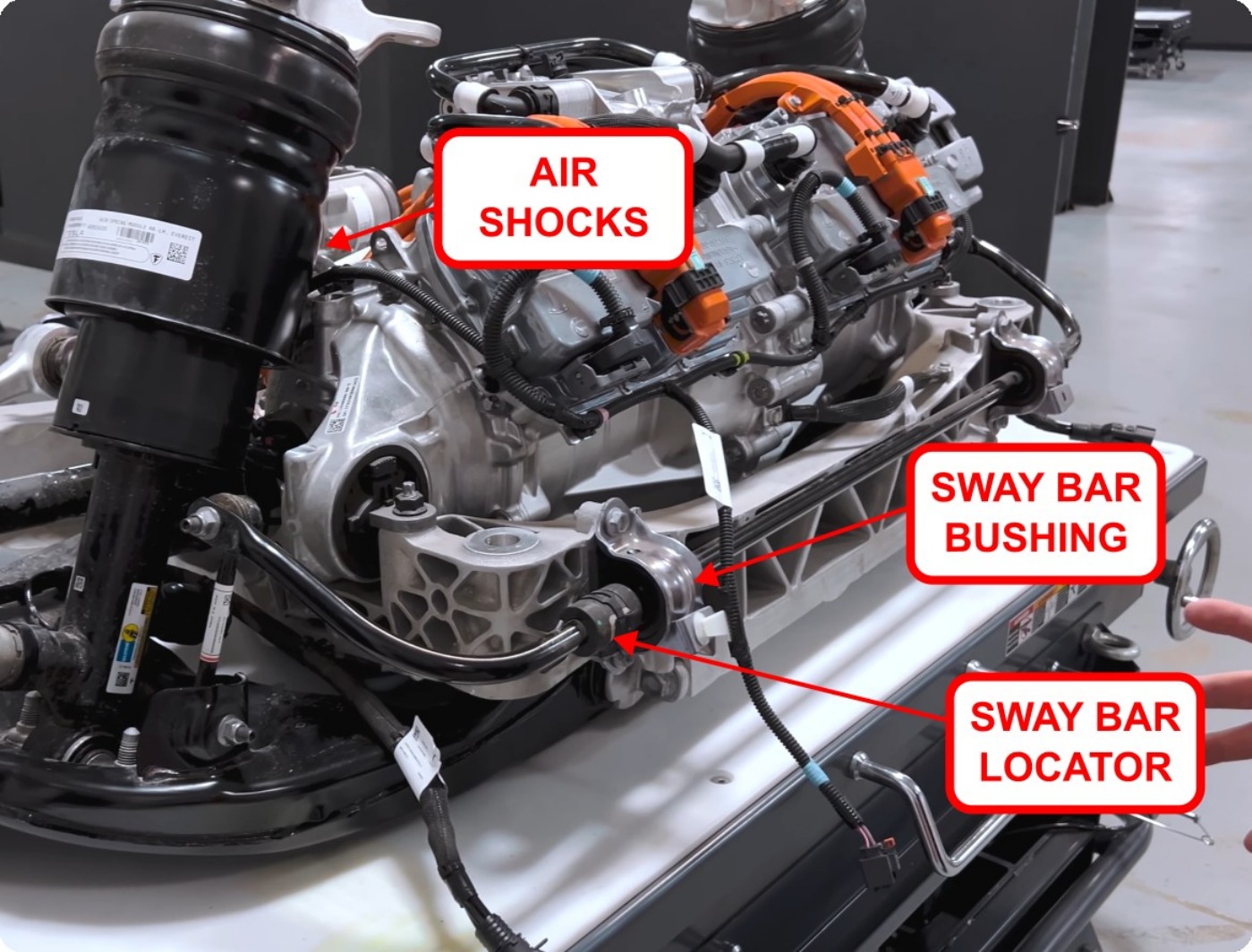
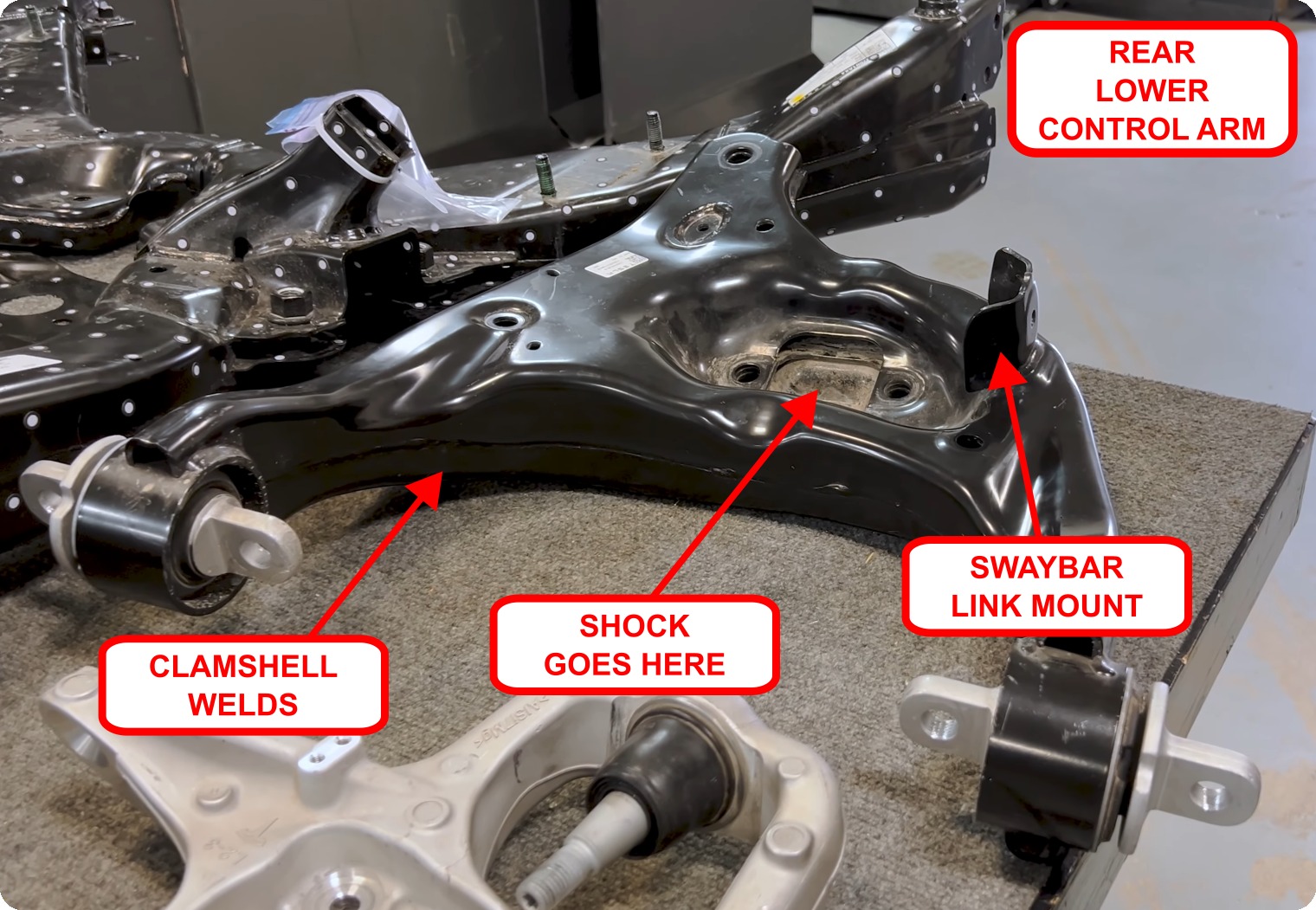
“When you look at the air [dampers] here for the Cybertruck… you can see, as far as material selection, [there is] lots of use of steel throughout,” says Herty. He also highlights the use of EPDM rubber parts that help keep dirt and other contaminants away from the air bladder assemblies. As for the air pump and reservoir, he notes that packaging them above the rear gigacasting leaves them very well protected. As for the pump itself, it’s mounted with very flexible rubber to minimize noise or vibrations transferred to the cabin. Herty explains that the Munro team was disappointed with the air reservoir itself though, noting it’s a standalone part that hasn’t been integrated with anything else to save costs.
“Personally, I’m not a huge fan of air ride, just from the complexity standpoint,” says Herty. “But air ride is a relatively cost-effective way to get, essentially, a lot of comfort in a vehicle.” While electromagnetic dampers can offer great performance and comfort as well, they come at a higher price. Herty puts this down to their requirement for clean room assembly, amongst other things. He notes that the Ram 1500 has used air ride to similar effect for several years now. It also makes it easy to change the vehicle’s ride height on a whim. “I think the air ride offers a nice balance between the cost of the system and performance for what you’re doing on trucks,” says Herty. “That’s typically why you see it in these segments, and not necessarily in more weight or performance-oriented segments like cars.”

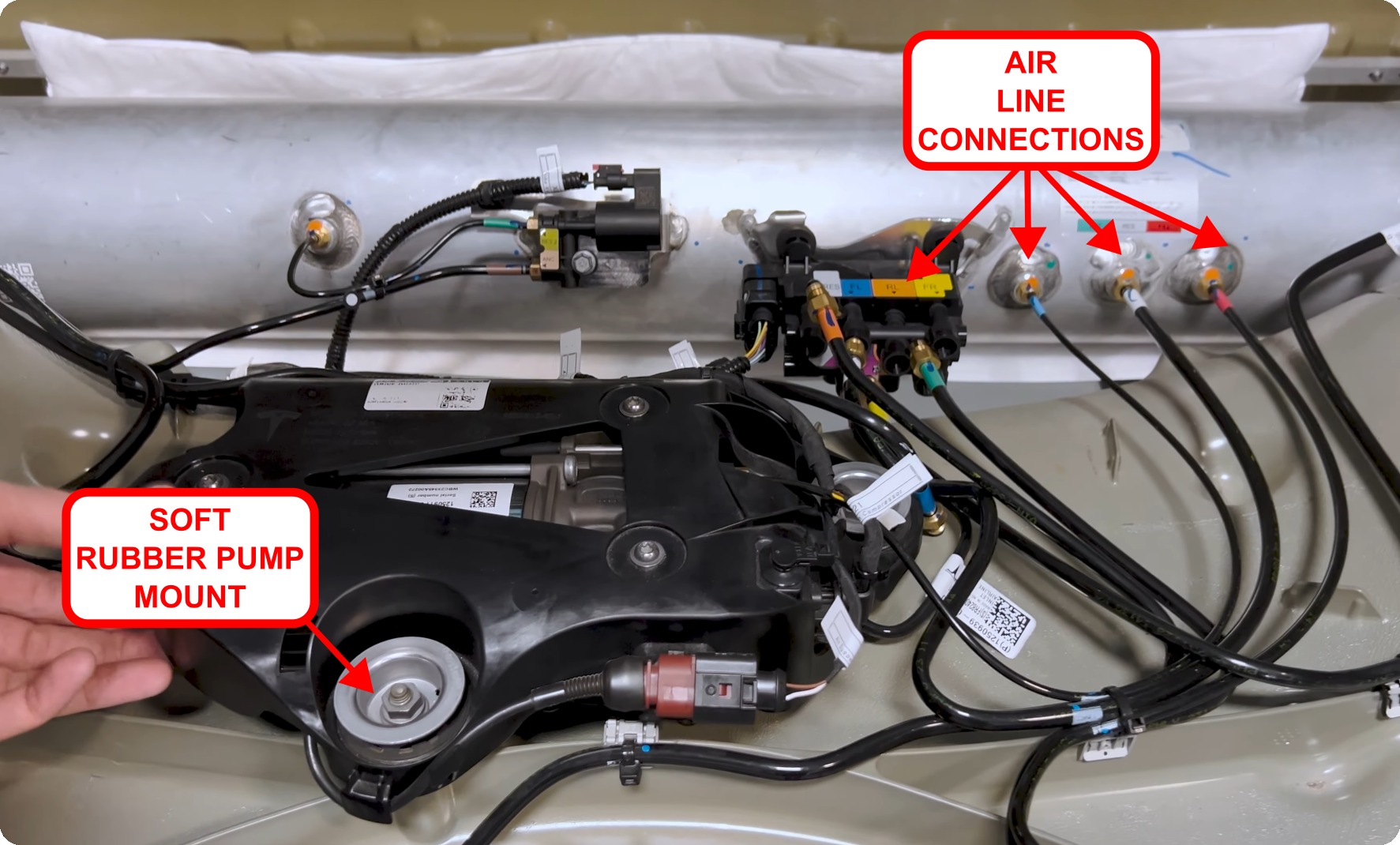
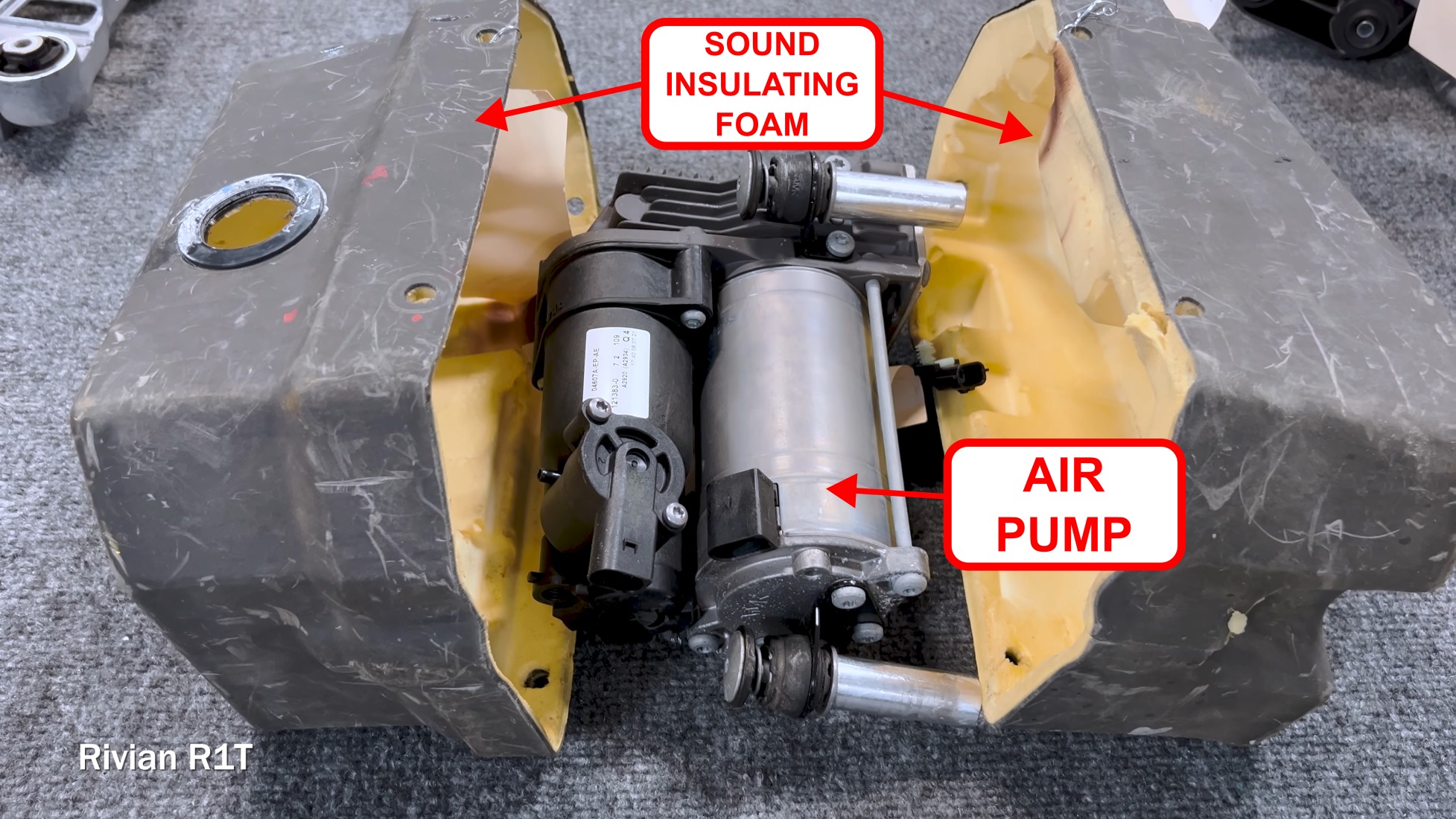
Harty contrasts the Cybertruck’s relatively simple air suspension system with the more complex route seen on Rivian’s vehicles. “Not only is the [Rivian] system twice as complex because it’s an air-over-hydraulic system, but all the materials throughout are more costly,” he says. However, he notes that Rivian’s design has some advantages. It has no need for swaybars, for one. Plus, it’s more tunable for different drive modes and ride heights, and each corner of the suspension is totally isolated.
Overall, it’s clear that cost has been a big driver of engineering decisions on the Cybertruck platform. “I think maybe some of those choices that we’re seeing here for both materials and even suspension system are to help offset the cost that we’re seeing elsewhere in the vehicle,” says Herty. He also notes that getting the truck to market in a reasonable time likely played a major role, too.
So often, what we learn about cars and trucks is limited to what we can see on the outside. We read reviews and maybe take a glance under the hood or under the body to get a better idea of how a vehicle performs and how it was built. But it’s hard to beat the real detailed look that you can get when you pull vehicle apart down to the individual component level.
Image credits: Munro Live via YouTube screenshot

The UCA looks very similar to the factory one on my 4Runner. Consus is that the upper arm isn’t under much load, the lower arm and ball joint take most of the weight.
Youtuber HeavyD Sparks (the Diesel Bros guy) got ahold of a CT and put tank tracks on it. It went pretty well until he destroyed the front suspension – they trashed the upper arm and broke the aluminum spindle. They fully admitted they pushed the truck way beyond design parameters and proceeded to build a custom suspension for it. He actually did a pretty good job of explaining how the stresses on the suspension work.
Side note, does anyone else look at that spindle and see Jonathan Davis’s mic stand?
Despite their technical qualifications, Munro and Associates have been such stans for Tesla and Musk that their opinions on Tesla vehicles have become completely predictable.
I’m beginning to ignore these guys the same way smokers ignore the warnings on cigarette packages.
Isn’t their expertise mostly in how to manufacture things for low cost and ease of assembly? Those are areas that I think Tesla had really been innovating; not necessarily the techniques in general, but in automotive use.
For instance, the very large single piece casting they try to use; in the late era of steam locomotive manufacturing in the US – say post 1920 – you started to see cast frames being used in some cases, instead of built-up frames. Those castings would dwarf anything Tesla is doing, and that was nearly a century ago.
I hate all the noise around Musk, because it gets into every conversation about Tesla and SpaceX, who are doing very interesting iterative approaches to design and manufacturing that go against the traditional models in their industries. However, I do think the claims about FSD are utter bunk and may end up costing Tesla big time.
It’s still interesting on a technical level, but it definitely feels like it’s shifted from “here’s the tradeoff they made for this design and why they likely made that choice” more towards “here’s why it’s a genius design” for Tesla specifically when it’s Munro talking.
I might be wrong but 99% sure this doesn’t have “air dampers”. I see air springs with hydraulic dampers. Article seems to imply that there is air damping, which doesn’t seem right.
Air over hydraulic on the Rivian refers not to the spring/shock but the main springs/ anti-roll system. Rivian is hydraulically linked like a McLaren
“Lots of folks have commented on the stamped-steel design, which looks relatively lightweight for a heavy off-road vehicle.However, Harty notes that it’s quite smart from a manufacturing perspective.”
“uses just a single stamped part, significantly reducing the cost of production”
So it’s lightweight and weak, but that’s OK because Tesla saved a lot of money instead of making it strong?
C’mon Owen, Read the whole article.
“In any case, the design of the Cybertruck’s suspension means that the upper control arm doesn’t see huge loads, anyway… “it’s essentially controlling camber,” …
Instead, most of the loads are carried by the lower control arm and passed directly into the shock.”
It always gets me how Munro casts cost cutting in such a positive light. Cutting out unnecessary expenses is one thing, but cheaping out on an upper control arm for an off reader will lead to a lot of stranded Cybertrucks. Munro is just a shill at this point and never considers durability, serviceability or reliability in his videos
You clearly don’t understand who pays Munro’s bills.
They’re manufacturing consultants; they are paid my manufacturers to help them find ways to make and assemble things more efficiently. In other words, their point of view is always going to be “how can we meet the required specification at the lowest material and labor cost?”
I get that–but there is absolutely no reason why a manufacturing consultant cannot consider repairability in their analysis
Why would they? It’s not in the automaker’s interest to spend a cent on repairability. Hell the revenue from servicing is mostly what keeps their dealerships – who are their actual customers – in business.
Maybe most customers don’t care about repairability, but many do. I wouldn’t consider a modern tesla since the battery isn’t repairable. GM explicitly designed Ultium to be opened up and repaired. As a result, I’d buy a used Ultium car in a heartbeat since I know you could actually repair it
You can’t pretend Customers don’t care about those things. Toyota sells as many cars as they do because of their reputation for reliability, not because their cars are the easiest and cheapest to build.
I have never seen a CV-to-hub interface like that Cybertruck one.
I’m used to the usual internal splines, with the CV axle nut doing nothing but gently holding the axle from sliding out of the hub. If the nut were to be slightly loose for some reason, nothing really would happen.
With the weird interface on the Cybertruck, it seems extremely dependent on the axle nut, perhaps putting greater loads on the axle nut, and it seems like if the axle nut was slightly loose the CV would be entirely disengaged. This seems like it could be a worse design, but is it really?
Many vehicles depend on the CV axle nut to hold the unit bearing together. I know GMT800 and first generation Tacoma for sure.
I knew that, actually because I learned it from a Tesla engineer ironically. But I’ve never heard of a vehicle that depends on the axle nut holding the CV engaged, at least not like this.
Every single GM vehicle from that era needs a replacement wheel hub bearing. They *all* go bad
That upper control arm has a lot in common with the one on my 1968 Ford Falcon… https://www.moog-suspension-parts.com/moog-rk621369
Any manufacturer making a two-piece, welded upper is doing it for a reason and it’s not that it didn’t occur to them to make a one-piece part. I assume they’re lighter for the same strength, for starters.
My assumption is that it’s related to up-front capital cost vs per-unit material cost. That is, less total material and less weight with a 2-piece part, but basically 2-3x the setup costs for the part.
Where the heck is Steven Walter Gossin? He’s my favorite writer here now that Tracy doesn’t have time for wrenching odysseys in the Outback…
DT needs to buy a Honda and a Subaru?
He’s rescuing like a million cars at once while working 70 hours a week. He’ll be back! ♥
I hope Sandy’s doing OK, his last rant was totally over the top. Missing Cory in those, although the guys are doing a good job too.
Smart stuff with the suspension design, I wish other industries would adopt capability to just think and be smart about choices they make.
Is that the one where he was talking about what a genius move it was to fire the entire supercharger team? That left me feeling awkward.
All the complaining about “it’s not strong enough for off-road” really don’t understand mechanical design.
I’m no fan of the Cybertruck, but none of those parts are weak in anyway. Heck, the “flimsy” sheet metal looks just a thick as what’s used for frame rails on tractor trailers.
But, it’s all a moot point, as the Cybertruck won’t see harsh off-road loads if it can’t get far off-road:
https://www.reddit.com/r/CyberStuck/comments/1cyrk4a/ramp_1_cucktruck_0/
I think my old Cavalier’s body flex had more articulation.
Some people have determined that they are very sharp indeed. Cutting edge, even.
I feel like the Ioniq 5 unitized wheel bearing/CV joint needs an article all to itself.
It seems cool, but I’d also wager at typical ~$100 wheel bearing replacement is now a $500 wheel bearing replacement, and the actual work is twice as hard.
Just another way to save manufacturing cost and make repairs more difficult and expensive. I don’t remember a wheel bearing ever failing back in the day when they were tapered rollers and adjusted on the spindle with a castellated nut. Now these unitized ball bearing deals fail regularly on nearly every make, but I can totally understand why the assembly plants love them.
But they are so much more efficient (until they fail and you get 5mpg until its fixed)
Unitized ball bearing wheel bearings are not remotely new, nor are they known for being short-lived or failure prone. I have original, non-greasable, unitized wheel bearings on my 1992 Accord which is at almost 290k miles.
The old skool tapered rollers that adjust preload with a castle nut can last a very long time, but with the design of the seals and lubrication, and with the human element of setting preload manually, there’s just a lot more ways to mess one up. Which I assume is why I have heard of them failing every now and then. Not common by any means, but it happens.
The earliest car I know of off the top of my head with unitized wheel bearings were the ’79 Toronado & Eldorado twins. I suppose there could be earlier examples but I don’t know what they are.
That’s about the right time frame. GM put in a line at New Departure Hyatt in Sandusky Ohio to build them. Now they’re mostly from China which likely contributes to the poor reliability.
Many mechanics have set wheel bearing castle nuts by feel instead of by torque wrench, counting on their experience to know when it’s right. The only reason this works most of the time is that there’s a good deal of tolerance in the design.
The unitized hub and bearing is a great idea. This is another case of “remove the human variable and increase reliability”. I won’t even argue against including the CV joint, considering how reliable those have become.
The overwhelming majority of unitized wheel bearing failures result from improper torque on the center nut.
There’s nothing in a unitized wheel bearing assembly that isn’t in tapered rollers really, the idea behind it is to remove inconsistencies in assembly and field service. It’s the same reason you can’t buy just a CV joint anymore.
As far as serviceability, personally I’d much rather unbolt a hub and put a new one back on, than punch races out of a hub and hand-pack bearings.
No argument there but in 60 years of cars I’ve never had a tapered bearing failure and probably changed a half dozen unitized. I’m surprised that the center nut torque is an issue on factory builds as this stuff is all done with electric drivers and torque monitoring. Almost all the ones I’ve had fail were factory builds.
Here’s my anecdote: 900+k miles of unitized bearings and one failure at around 50k miles in a ’12 Focus likely from hydroplaning into a caterpillar barrier at about 50 mph. My ’90 Legacy had 270k on its bearings including fording water up to the headlights, braking from 3-figure speeds down a mountain, lots of J-turns, a hand brake turn into a curb that slightly bent the rear wheel, and a top speed run of 130+. That said, in spite of the way I used to drive, I’ve very rarely had to replace any other components, either—even alignments, I’ve only needed due to component replacement that necessitated it, components that far outlived their expected life span, so maybe that’s just me.
I believe most bearing failures are down to improper torquing or slightly off square installation when pressing them in probably in no small part to being the kind of job they often give low-experience mechanics.
More important is the CV axle replacement. If I understand correctly, you can no longer replace a $100 CV, you have to completely disassemble the brakes and hub to replace the wheel bearing and CV as one part.
I say more important because 1. I’m used to CVs failing much more often than wheel bearings, and 2. CVs are usually really easy, and removing a wheel bearing is much much more involved.
How much suspension strength do the Kardashians and Justin Bieber really need to bop around SoCal?
Aluminum Mystery Nubbin is the name of my Maroon5† cover band.
† I don’t actually have a Maroon5 cover band.